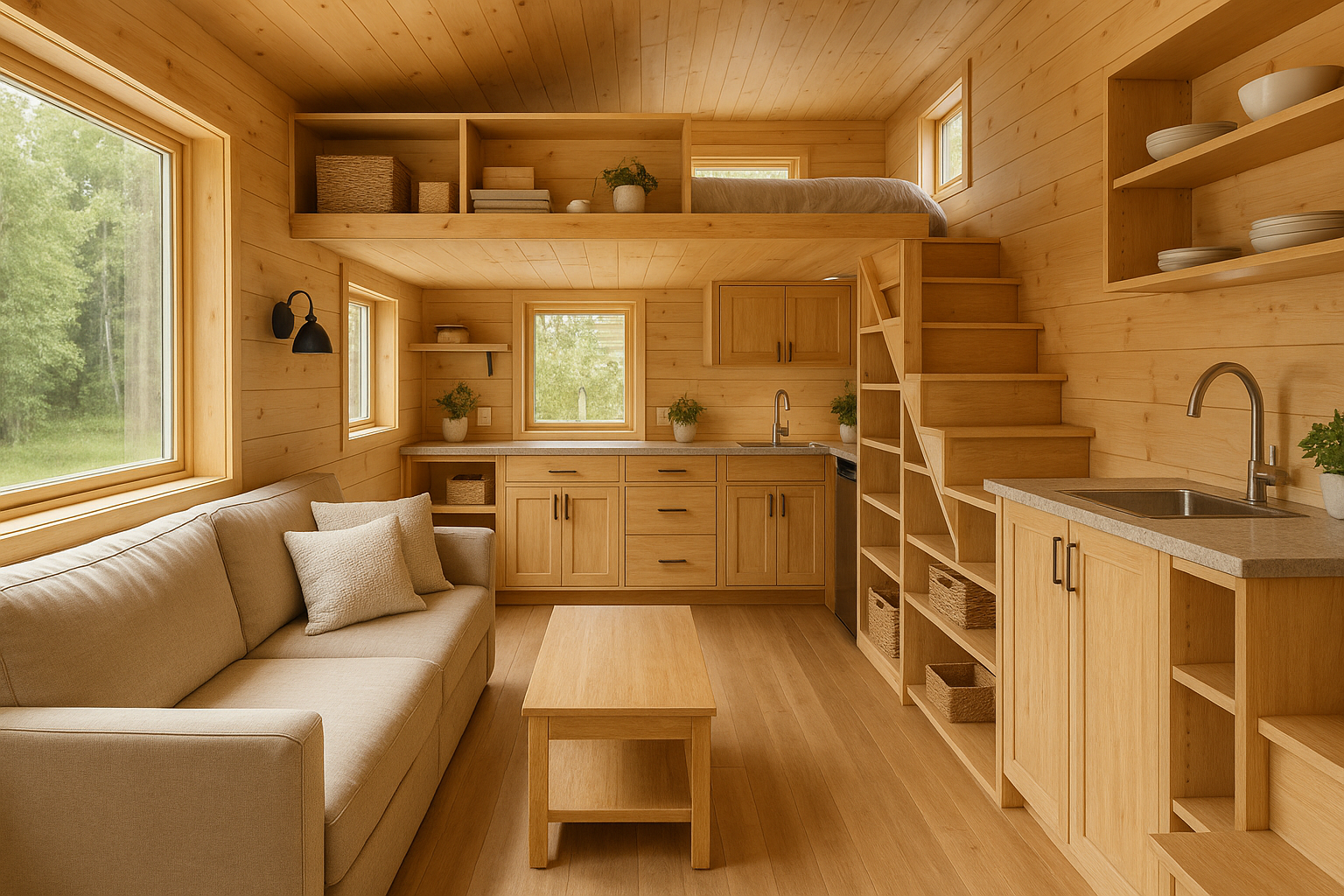
Transform Your Space: How Custom Furniture Revolutionizes Canadian Tiny Houses
Estimated reading time: 7 minutes
Key Takeaways
- Custom solutions for tiny spaces: Tailor-made furniture maximizes every inch and adds multifunctional use.
- Innovative storage ideas: Built-in storage and convertible designs address the challenges of compact living.
- Eco-friendly and efficient design: Canadian tiny houses benefit from sustainable materials and climate-ready plans.
- Personalized interior design: Smart use of light, colours, and flexible layouts transforms small spaces into stylish homes.
Table of contents
- Understanding Canadian Tiny Houses
- The Essential Role of Custom Furniture in Tiny Home Storage
- Space-Saving Ideas: Innovative Custom Furniture for Tiny Homes
- Interior Design Strategies: Making Small Spaces Shine
- Practical Tips: Bringing Custom Furniture to Your Tiny Home
- Conclusion
- Frequently Asked Questions
Tiny homes are rising in popularity across Canada, transforming how people think about small-space living. More Canadians are choosing minimalism, sustainability, and clever design to make life in compact spaces enjoyable. At the heart of this movement is custom furniture—a cornerstone for maximizing every inch, organizing tiny home storage, and ensuring a beautiful, functional interior design.
In this blog post, you’ll learn how custom furniture supports Canadian tiny houses with innovative space-saving ideas. We’ll explore modern storage solutions, interior design strategies, and actionable tips for tailoring your space. Whether you’re planning your own tiny house or enhancing a current space, these ideas will help turn your interior into a model of efficiency and style.
For more about the tiny home movement in Canada, check out
this guide and
this resource.
Understanding Canadian Tiny Houses: Compact Living Challenges
Canadian tiny houses typically range from 100 to 400 square feet, doubling as accessory dwelling units (ADUs) for extra space or rental income. Their design reflects a growing demand for affordable, flexible, and eco-friendly living options across Canada.
Key Features of Canadian Tiny Houses:
- Multi-use layouts: Rooms and furniture serve several purposes to save space. Learn more about multi-functional room designs at this link.
- Eco-friendly design: Use of energy-efficient appliances, sustainable materials, and low-waste construction techniques.
- Climate readiness: Durable insulation, triple-glazed windows, and effective heating are crucial for withstanding harsh Canadian winters. Detailed requirements can be found at this checklist.
The limited square footage promotes overlapping functions and demands innovative storage that stays hidden yet functional. Consider decluttering and minimalist routines by referring to this guide.
The Essential Role of Custom Furniture in Tiny Home Storage
Custom furniture is designed for specific spaces and functions, ensuring every nook is optimally used. In tiny homes, off-the-shelf pieces may not fit, making bespoke furniture essential.
- Exact fit: Every measurement is taken to utilize unusual floorplans and sloped walls.
- Built-in storage: Features like drawers, shelves, or cubbies integrated into benches or stairs eliminate the need for extra bulky cabinets.
- Multi-functional use: Furniture often plays dual roles—transforming a bench into a bed or a desk into a dining table.
- Personalized design: Tailored pieces match personal storage needs, from clothing to pantry items. Explore more smart storage ideas at this resource.
Space-Saving Ideas: Innovative Custom Furniture for Tiny Homes
Discover the transformative space-saving ideas that make tiny home living both efficient and stylish. Smart designs blend function with modern aesthetics:
Standout Custom Furniture Solutions
- Foldable tables: These dining or work surfaces can be folded away to free up space. Wall-mounted versions hide neatly when not in use.
- Built-in benches with storage: Seating areas with hidden drawers or lift-up compartments for blankets, gear, or shoes.
- Multi-functional beds: Murphy beds or platform beds with concealed storage transform sleeping areas into living spaces.
- Convertible desks and tables: Easily switch from a work desk to a dining table. For additional ideas on home office integration, visit this link.
- The “Origami Kitchen”: Inspired by folding paper, this design conceals kitchen elements until needed, reducing clunky appliances and cabinets.
Each piece uses sleek finishes and quality materials, combining beauty with practicality.
Interior Design Strategies: Making Small Spaces Shine
Effective interior design is the secret ingredient to integrating custom furniture beautifully. Consider these techniques:
- Choose light colours: Pales shades and neutrals visibly expand the space.
- Reflective materials: Using glass, large mirrors, or polished metals help bounce light throughout the room.
- Flexible layouts: Open spaces and sliding doors allow interiors to adapt to changing needs.
- Layered lighting: Combining ambient, task, and accent lighting ensures every area is well-illuminated.
- Minimal décor: Keep clutter at bay by selecting a few meaningful pieces that complement your custom furniture. For further insights into minimalist design, visit this guide.
Practical Tips: Bringing Custom Furniture to Your Tiny Home
Ready to revolutionize your Canadian tiny house with custom furniture? Follow these actionable steps:
- Assess your needs: List your essentials versus nice-to-have items covering clothing, cooking, and storage.
- Measure all spaces: Detailed measurements, including under stairs and narrow corridors, are crucial.
- Consult with experts: Local designers and carpenters can create bespoke solutions based on your measurements and needs.
- Prioritize multifunctional designs: Opt for furniture that serves dual or triple purposes, such as beds with drawers or convertible tables.
- Integrate storage everywhere: Utilize every nook—from under-stair drawers to mounted shelves above windows.
- Visit tiny home expos: Events like the Tiny Home Show Ontario offer inspiration and professional advice. More information is available at this expo page.
- Plan for flexibility: Use modular shelving or rolling cabinets that can adapt as your needs change.
Conclusion: Why Custom Furniture Sets Canadian Tiny Homes Apart
Custom furniture is not merely a luxury—it’s a necessity in Canadian tiny houses. These bespoke solutions provide maximal storage, unparalleled comfort, and a design tailored to your unique space.
- Maximal storage: Every inch is optimized to keep clutter at bay.
- Comfort & style: Each custom piece harmonizes with your home’s interior design for a seamless look.
- Flexibility and sustainability: Adaptable pieces made with eco-friendly materials ensure your home grows with your needs. For ideas on green building materials, visit this resource.
Combining striking custom furniture with smart interior design and clever space-saving ideas is the ultimate recipe for a welcoming, efficient Canadian tiny home.
Frequently Asked Questions
What makes custom furniture ideal for tiny homes?
Custom furniture is crafted to fit unique layouts and maximize storage, ensuring every space is used efficiently in a tiny home.
How can I determine the right custom design for my space?
Start by measuring every area of your home and listing your storage needs. Consulting with local design experts can then help you tailor furniture that suits both your space and lifestyle.
Are these custom solutions eco-friendly?
Many custom furniture makers prioritize sustainable materials and energy-efficient methods, making them an eco-friendly option for modern Canadian tiny homes.
Can custom furniture adapt to future changes in my space?
Yes, by choosing multifunctional and modular designs, custom furniture can easily adapt as your needs evolve.

Leave a Reply